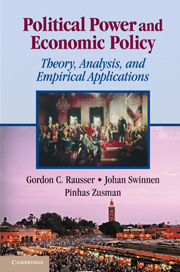Book contents
- Frontmatter
- Contents
- List of Figures
- List of Tables
- Preface
- PART 1 POLITICAL POWER AND ECONOMIC ANALYSIS
- PART 2 IDEOLOGY, PRESCRIPTION, AND POLITICAL POWER COEFFICIENTS
- PART 3 ANALYSIS OF SPECIFIC STRUCTURES
- PART 4 EMPIRICAL APPLICATIONS OF POLITICAL POWER ESTIMATION
- 20 Political Econometrics
- 21 The Political Econometrics of the Israeli Dairy Industry
- 22 Flexible Policy Instruments Given a Political-Power Distribution
- 23 Estimating Statistical Properties of Power Weight Parameters and Their Temporal Shifts
- 24 The Role of Institutions in the Joint Determination of PERTs and PESTs
- References
- Index
22 - Flexible Policy Instruments Given a Political-Power Distribution
Published online by Cambridge University Press: 05 June 2012
- Frontmatter
- Contents
- List of Figures
- List of Tables
- Preface
- PART 1 POLITICAL POWER AND ECONOMIC ANALYSIS
- PART 2 IDEOLOGY, PRESCRIPTION, AND POLITICAL POWER COEFFICIENTS
- PART 3 ANALYSIS OF SPECIFIC STRUCTURES
- PART 4 EMPIRICAL APPLICATIONS OF POLITICAL POWER ESTIMATION
- 20 Political Econometrics
- 21 The Political Econometrics of the Israeli Dairy Industry
- 22 Flexible Policy Instruments Given a Political-Power Distribution
- 23 Estimating Statistical Properties of Power Weight Parameters and Their Temporal Shifts
- 24 The Role of Institutions in the Joint Determination of PERTs and PESTs
- References
- Index
Summary
Introduction
In many policy areas, policies are not determined or changed in a semi-continuous process, but are fixed for certain periods and are reviewed and changed at the end of every period – at which time the policy changes may be substantial. However, the practice of changing policy substantially every period may impose unnecessary transaction costs on the sector. Inefficiencies may result from production and investment decisions based on unstable expectations about new programs' effects on the sector, and from uncertainty regarding what programs will be adopted in future years.
One example of such a policy approach is the U.S. agricultural policy, where every four years a new “Farm Bill” fixes the policy for the next four-year period. In fact, prior to the 1985 Farm Bill (U.S. Department of Agriculture 1986), agricultural policy instruments were set within narrow limits and changed little from their predetermined levels regardless of changes in the economy or international conditions during the life of the Farm Bill. This policy approach was severely critiqued during the early 1980s, when U.S. agriculture underwent its worst financial crisis since the Great Depression in spite of record spending on government agricultural programs. In the early 1980s, the strong dollar and large crop production worldwide resulted in large reductions in U.S. grain exports and large increases in U.S. grain inventories, driving prices down to support levels (Rausser et al. 1986). However, during this period the United States maintained its grain support prices at levels set in the 1981 Farm Bill.
- Type
- Chapter
- Information
- Political Power and Economic PolicyTheory, Analysis, and Empirical Applications, pp. 424 - 450Publisher: Cambridge University PressPrint publication year: 2011



